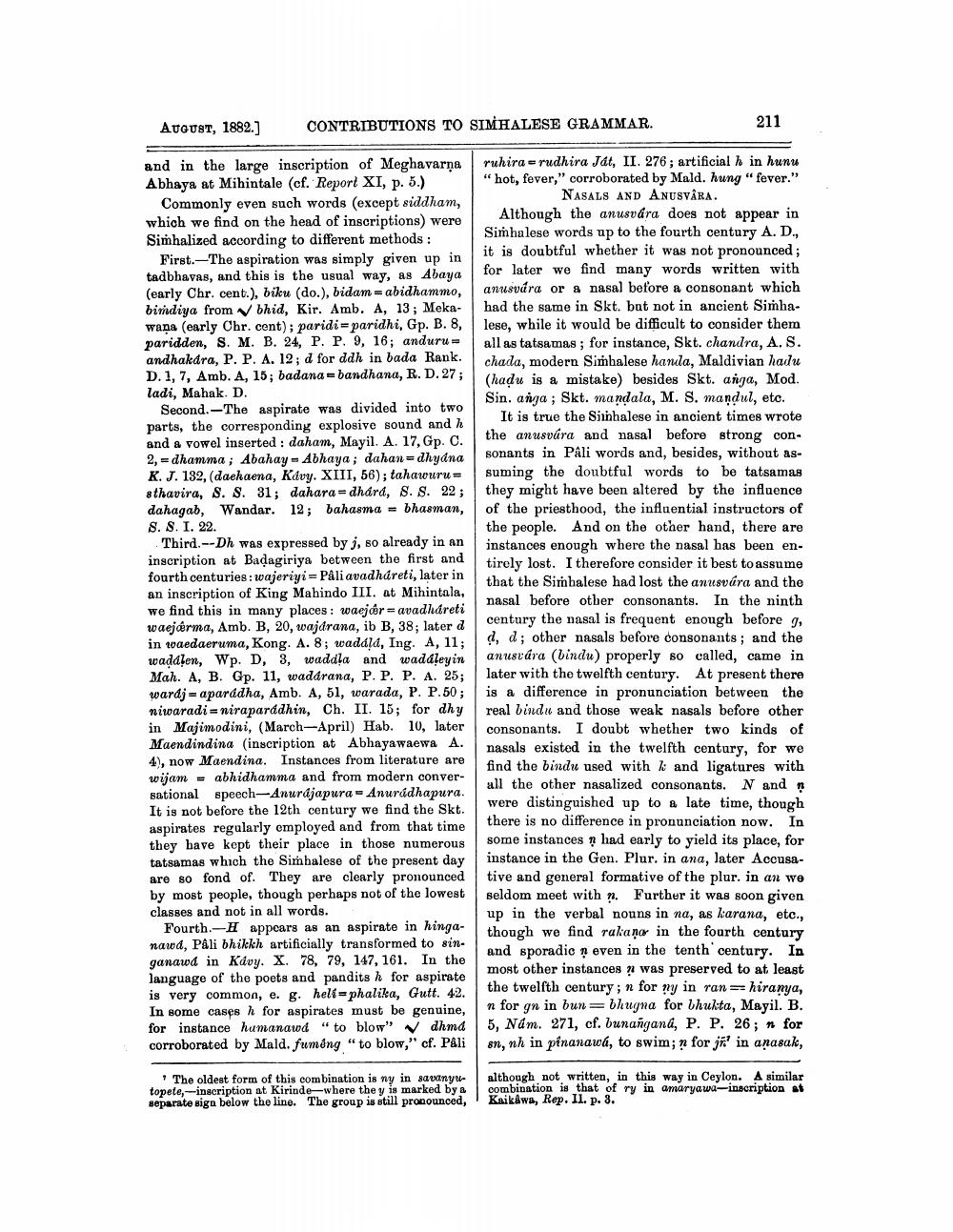________________
AUGUST, 1882.]
CONTRIBUTIONS TO SIMHALESE GRAMMAR.
211
and in the large inscription of Meghavarna ruhira -rudhira Ját, II. 276; artificial ) in hunu Abhaya at Mihintale (cf. Report XI, p. 5.) "hot, fever," corroborated by Mald. hung "fever." Commonly even such words (except siddham,
NASALS AND ANUSVÅRA. which we find on the head of inscriptions) were
Although the anusvára does not appear in Simhalized according to different methods :
Simhalese words up to the fourth century A. D., First.-The aspiration was simply given up in
it is doubtful whether it was not pronounced ; tadbhavns, and this is the usual way, as Abaya
for later we find many words written with (early Chr. cent.), biku (do.), bidam-abidhammo, anusvára or a nasal before a consonant which birdiya from bhid, Kir. Amb. A, 13; Meka- had the same in Skt. but not in ancient Simhawaņa (early Chr. cent); paridi= paridhi, Gp. B. 8, lese, while it would be difficult to consider them paridden, S. M. B. 24, P. P. 9, 16; anduru = all as tatsamas; for instance, Skt. chandra, A. S. andhakdra, P. P. A. 12; d for ddh in bada Rank.
chada, modern Simbalese hanula, Maldivian halu D. 1, 7, Amb. A, 15; badana=bandhana, R. D. 27;
(hadu is a mistake) besides Skt. anga, Mod. ladi, Mahak. D.
Sin. anga; Skt. mandala, M. S. mandul, etc. Second. -The aspirate was divided into two parts, the corresponding explosive sound and h
It is true the Sinhalese in ancient times wrote and a vowel inserted : daham, Mayil. A. 17, Gp. C.
the anusvára and nasal before strong con2, - dhamma; Abahay - Abhaya; dahan-dhydna
sonants in Páli words and, besides, without asK. J. 132, (daehaena, Kavy. XIII, 56); tahawuru = suming the doubtful words to be tatsamas sthavira, 8. S. 31; dahara=dhard, 8. 8. 22; they might have been altered by the influence dahagab, Wandar. 12; bahasma - bhasman, of the priesthood, the influential instructors of S. S. I. 22.
the people. And on the other hand, there are Third. --Dh was expressed by j, so already in an instances enough where the nasal has been eninscription at Badagiriya between the first and
tirely lost. I therefore consider it best to assume fourth centuries: wajeriyi = Páli avadhdreti, later in
that the Sinhalese had lost the anusvára and the an inscription of King Mahindo III. at Mihintala, we find this in many places : waejør = avadhdreti
nasal before other consonants. In the ninth waejárma, Amb. B, 20, wajdrana, ib B, 38; later d
century the nasal is frequent enough before , in waedaeruma, Kong. A. 8; wadaļa, Ing. A, 11;
1, d; other nasals before consonants; and the wadalen, Wp. D, 3, waddla and waddleyin anusvára (bindu) properly so called, came in Mah. A, B. Gp. 11, waddrana, P. P. P. A. 25; later with the twelfth century. At present there wardj - aparddha, Amb. A, 51, warada, P. P.50; is a difference in pronunciation between the niwaradi = niraparddhin, Ch. II. 15; for dhy real bindu and those weak nasals before other in Majimodini, (March-April) Hab. 10, later consonants. I doubt whether two kinds of Maendindina (inscription at Abhayawaewa A. nasals existed in the twelfth century, for we 4), now Maendina. Instances from literature are
find the bindu used with k and ligatures with wijam - abhidhamma and from modern conversational speech-Anurdjapura - Anuradhapura.
all the other nasalized consonants. N and ? It is not before the 12th century we find the Skt.
were distinguished up to a late time, though aspirates regularly employed and from that time
there is no difference in pronunciation now. In they have kept their place in those numerous
some instances had early to yield its place, for tatsamas which the Simhalese of the present day instance in the Gen. Plur. in ana, later Accusaare so fond of. They are clearly pronounced tive and general formative of the plur. in an we by most people, though perhaps not of the lowest seldom meet with n. Further it was soon given classes and not in all words. A
up in the verbal nouns in na, as karana, etc., Fourth.-H appears as an aspirate in hinga
though we find rakaņo in the fourth century nawd, Pali bhilekh artificially transformed to sin
and sporadic î even in the tenth century. In ganawd in Kavy. X. 78, 79, 147, 161. In the language of the poets and pandits h for aspirate
most other instances ? was preserved to at least is very common, e. g heli-phalika, Gutt. 42.
the twelfth century; n for ny in ran == hiranya, In some cases h for aspirates must be genuine, n for gn in bun = blugna for bhukta, Mayil. B. for instance humanawd "to blow" ~ dhmd 5, Nam. 271, cf. bunañgand, P. P. 26; " for corroborated by Mald, fumong "to blow," cf. Páli sn, nh in pinanawá, to swim; ? for ji' in anasak,
The oldest form of this combination is ny in savinyu topete, inscription at Kirinde where they is marked by a separate siga below the line. The group is still pronounced,
although not written, in this way in Ceylon. A similar combination is that of ry in amaryaw-inscription at Kaikawa, Rep. Il. p. 3.




